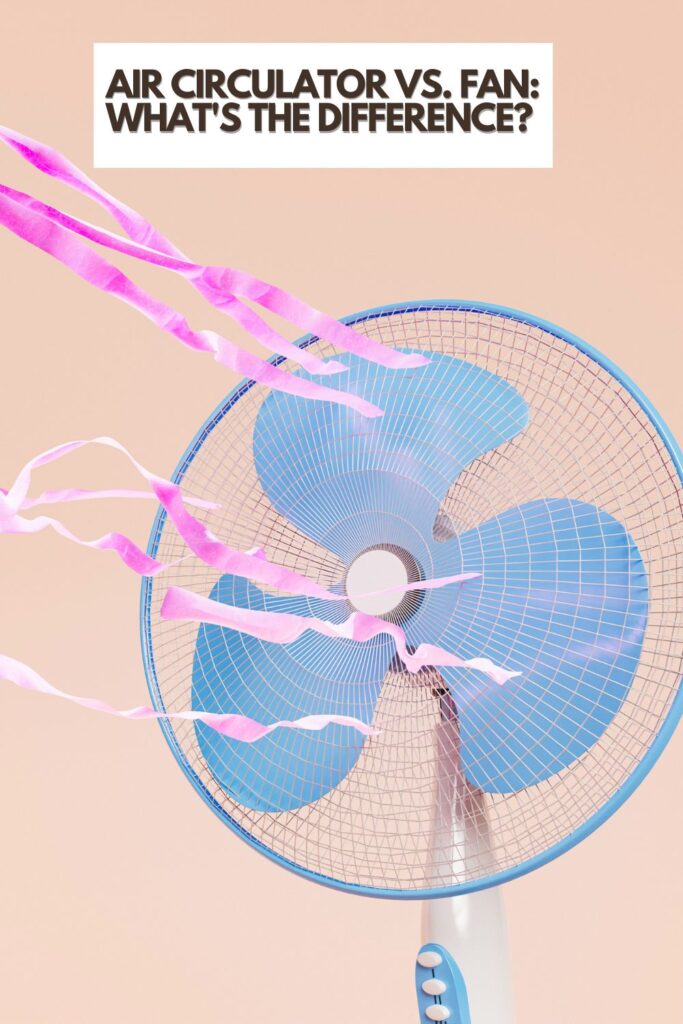Are you wondering what’s the difference between an air circulator vs. a fan? When it comes to keeping your space cool and comfortable, both air circulators and fans play a crucial role. However, while they may seem similar on the surface, these devices offer different benefits and functionality. With numerous factors to consider, understanding the differences between air circulators and fans can be essential when selecting the best option for your cooling needs.
We recently purchased a Vornado Whole Room Air Circulator from Amazon and we are so happy we did. It has been a great supplement to our air conditioner in our house.
FTC DISCLOSURE: Some of the links in this post are affiliate links. If you click on them and make a purchase, I will receive a small finder’s fee on the sale. This does not increase your price in any way shape or form. Using these links help support the continuation of this website. All opinions are my own. Thank you in advance.
Air circulators work by creating continuous airflow throughout a room, ensuring that the existing air is evenly distributed and maintains a consistent temperature. On the other hand, fans typically provide a focused stream of air in one direction, offering more targeted cooling relief. The critical distinction between these two lies in their cooling approach and energy efficiency, with each having its unique advantages and disadvantages.
Key Takeaways
- Air circulators and fans serve different purposes in maintaining a comfortable space through distinct cooling approaches.
- Energy efficiency and noise levels are vital factors to consider when choosing between air circulators and fans.
- Additional benefits such as portability and functionality can influence the decision based on individual needs and preferences.
You Might Also Like To Read:
How To Price Match At Target The Right Way

What is an Air Circulator
An air circulator is a type of appliance designed to improve the overall airflow and create a more comfortable environment within a given space. They work by using advanced aerodynamics to efficiently move and circulate air throughout the room. Air circulator fans differ from traditional fans in several ways, which can provide distinct advantages in various situations.
What is the difference between and Air Circulator & a Pedestal Fan?
One of the key features of an air circulator is vortex action. This technology creates a spiral column of air, which enables the air to travel farther and more evenly throughout a room. This results in consistent and uniform temperature throughout the space, eliminating hot and cold spots that are common with traditional fans.
Air accelerators are another feature found in some air circulators. These accelerators help direct and increase the velocity of the air, optimizing the airflow for maximum circulation. This efficient air movement also helps to balance the temperature, enhance indoor air quality, and improve energy efficiency by reducing the need for heating and cooling systems to work as hard.
Air circulator fans are designed with complex aerodynamics in mind, which allows them to move a greater volume of air with less noise and energy consumption compared to traditional fans. The airflow pattern generated by an air circulator promotes better circulation and can even aid in ventilation or air purification when used in combination with other systems.
What is a Fan vs. an Air Circulator?
A fan is a common household appliance designed to create airflow and improve ventilation. Fans come in a variety of styles and types, each offering different benefits depending on the specific needs of the user.
Traditional fans, such as table fans, box fan, and floor fans, are often small and portable, making them ideal for personal use and small spaces. Table fans, as the name suggests, are designed to be placed on a table or other flat surface. Floor fans, on the other hand, are larger and can be placed directly on the floor. Both types typically offer adjustable speed settings to provide the desired level of airflow.
A Ceiling fan is another popular type of fan, often used to circulate air throughout larger rooms. Mounted to the ceiling, these fans offer a more permanent cooling solution and can be paired with a light fixture in the middle for added functionality.
Oscillating fans, such as pedestal fans and tower fans, deliver air flow in a rotating or sweeping motion to better distribute cool air throughout a room. Pedestal fans are elevated on a tall stand, while tower fans are usually slender and vertically oriented. Both types can feature adjustable speed and oscillation settings to customize the cooling experience.
Box fans are another option, designed with a square or rectangular frame surrounding an array of fan blades. These fans can be easily placed in windows, or on the floor to circulate air within a room.
Each type of fan offers unique benefits to suit various needs, from personal use to whole-room cooling. Regardless of the type, all fans operate by using a motor to rotate blades or fins, creating airflow that cools the surrounding environment. With countless options available, there is a fan to meet the needs of any space or individual.
Comparison of Air Circulators and Fans
When comparing air circulators and fans, it is essential to understand the key differences in their functionality, design, and intended use. Both types of devices serve to create airflow, making indoor spaces more comfortable. However, they differ in the way they circulate air and their effectiveness in various situations.
Air circulators are specifically designed to create a continuous flow of air throughout a room. They do this by pushing air outward in a conical pattern, then drawing surrounding air back in and creating a vortex. This continuous circulation evenly distributes air, resulting in a more balanced and efficient cooling effect.
Air circulators are ideal for larger spaces and areas with poor natural ventilation. When it comes to energy efficiency, air circulators consume less energy compared to typical fans. They are also versatile, as they can be used for cooling, heating, and air purification.
Fans operate on a more straightforward principle: they move air in a straight line, creating a localized breeze. They typically have blades that spin around an axis, propelling air forward. Fans are an excellent choice for quickly cooling down a specific area and providing immediate relief on hot days.
However, they are not as effective at evenly distributing air throughout a room, which can lead to uneven temperatures. Their energy consumption varies depending on the size and type of fan, with larger and more powerful fans consuming more energy.
When selecting an air movement device, consider factors such as room size, desired comfort level, and energy efficiency. Air circulator fans effectively combine the benefits of both air circulators and fans, offering versatility for different cooling needs. These devices can either operate independently, providing targeted cooling like a typical fan, or be used in conjunction with an air circulator to enhance overall air circulation.
Cooling Efficiency & Continuous Motion
When comparing air circulators and fans, it is important to consider their ability to cool a space efficiently. Cooling efficiency can be influenced by a variety of factors such as performance, temperature regulation, and evaporation.
Air circulator fans use vortex technology to create a continuous flow of air throughout a room. This provides consistent cooling and temperature distribution, resulting in a more comfortable environment. Additionally, air circulators can help promote evaporation by drawing cooler air up from the ground and circulating it upwards.
This process not only enhances the cooling effect but also helps to keep the surrounding area dry and free of excess moisture. The vortex action of this fan is is exactly what makes it different than a free-standing filter air purifiers, or a standard fan. In our home, we have 2 air conditioners, 2 whole room air circulators and 2 HEPA air purifiers.
On the other hand, fans primarily focus on providing directed airflow, which can lead to uneven cooling and temperature fluctuations within a space. The performance of a fan largely depends on its power and the size of its blades. Bigger blades and higher power output may lead to more efficient cooling, but the overall effect may still be limited when compared to an air circulator.
Outdoor use also plays a role in determining the efficiency of both air circulators and fans. Air circulators tend to be less effective outdoors due to the absence of walls or barriers to contain the airflow. Fans, however, can still be used to provide targeted cooling, making them a more suitable option for outdoor events and activities.
In terms of energy consumption, air circulators and fans can be relatively efficient cooling solutions. To maximize their energy efficiency, opt for models equipped with energy-saving features, such as automatic shut-off and adjustable speed settings.
Energy Efficiency
In terms of energy efficiency, there are noticeable differences between air circulators and fans. Energy efficiency is crucial as it affects power consumption, electricity usage, and monthly energy bills.
Whole Room Air Circulator fan.products utilize a compact design and advanced mechanisms to enhance air movement throughout a room. They consume relatively less power compared to traditional fans. By promoting continuous air circulation, air circulators facilitate even cooling and heating, leading to a reduction in energy consumption by air conditioners or heaters, thereby lowering monthly energy bills.
On the other hand, fans simply propel air in a specific direction, and their efficiency is largely dependent on design and size. The power consumption of fans varies significantly, with larger fans demanding more energy. Ceiling fans designed with energy conservation in mind can be energy efficient, but they do not contribute as much to reducing the need for air conditioners or heaters.
Noise Level
Air circulators and regular fans both emit noise that can vary in loudness and frequency when in operation. However, there are some considerable differences between the noise levels they produce.
Air circulators often have quieter motors in comparison to regular fans. Many air circulators are designed with noise reduction in mind since they have enclosed motors, which dampen the sound of the spinning blades. This enables users to enjoy a more peaceful environment without being disturbed by the presence of a loud, buzzing appliance.
The noise level of a regular fan depends on several factors such as its size, speed settings, and type (e.g., pedestal, box, or tower). Generally, larger fans produce more noise than smaller ones. Additionally, using a fan on a higher speed setting will make it louder than when it’s on a more relaxed, low-speed setting.
An essential aspect to consider is the type of noise generated by air circulators and regular fans. Some users prefer the soothing sound of a constant hum or white noise produced by air circulators, as this type of noise can be less distracting than the fluctuating noise levels of a regular fan.
Moreover, choosing a product with quality construction and proper vibration dampening materials can reduce the noise emitted by both air circulators and regular fans. On the market, there are fan models that have been specifically designed to operate quietly, catering to individuals who value a noise-free environment.
Airflow and Oscillation
Air circulators and traditional fans both have the primary function of moving air, but they differ in the way they approach airflow and oscillation. By understanding their unique characteristics, you can choose the most suitable option to maintain fresh air circulation in your space.
Air circulators work by creating a continuous flow of air throughout a room, effectively replacing stale air with fresh air. They achieve this by producing a directional airflow, which bounces off walls and other surfaces, resulting in a fluid movement of air. Their design often includes a vortex action, which helps to maintain constant air circulation. This method not only enhances the distribution of fresh air but also helps in equalizing the room temperature.
On the other hand, traditional fans or a table fan focus primarily on providing a direct, linear airflow, which moves air from one source point and propels it towards a limited area. Their oscillation feature allows the fan head to move from side to side, covering a specific range and briefly refreshing the immediate surroundings. This process, unfortunately, does not ensure the efficient distribution of fresh air throughout an entire room.
Ducts play a minimal role in air circulation when it comes to portable fans and air circulators, as they are typically associated with central air systems. However, for centralized air systems, proper duct maintenance and cleanliness are crucial to keep the air circulated within the vents free from contaminants and to ensure optimal performance.
Free-standing air purifiers are important when it comes to improving indoor air quality. This is much different than the purpose of an air circulator fan or desk fans.
You Might Also Like To Read:
AirDoctor HEPA Air Purifier Review
Functionality and Portability
Air circulators and fans both serve the primary purpose of moving air to create a more comfortable environment. However, there are some differences in their functionality that can influence their suitability for various room sizes and placement.
Air circulators are designed to create a continuous airflow throughout a room, distributing the air evenly and eliminating hot and cold spots. They often have multiple speed settings, allowing users to adjust the intensity of the circulation to match their needs. This flexibility makes air circulators suitable for a wide range of room sizes, as they can effectively disperse air in small, medium, or large spaces.
On the other hand, fans mainly provide a focused, directional airflow. Unlike air circulators, they do not efficiently distribute air throughout a room, making them more suited for targeted cooling in smaller spaces or for personal use. Moreover, the range and effectiveness of fans may diminish with increasing room size or when placed in challenging locations, such as corners.
When it comes to portability, there is a notable distinction between the two types of devices. Air circulators tend to be bulkier and heavier compared to fans, which may affect their ease of transportation and placement within a room. Fans, especially portable models like table fans and tower fans, are often lighter and more compact, making them easier to move around and position as needed.
Additional Benefits and Considerations
Air circulators and fans both provide effective relief on hot summer days. However, they differ in how they achieve a comfortable environment and interact with other heating and cooling systems. This section will cover some of the additional benefits and considerations to better understand these devices.
Using an air circulator can improve the room’s temperature by evenly distributing cool or warm air throughout the space. Unlike traditional fans, air circulators work to eliminate cold spots by creating a continuous, smooth airflow. They also enhance the efficiency of heaters and air conditioners. By dispersing the conditioned air, air circulators reduce the burden on heating and air conditioning systems, ultimately resulting in energy savings.
On the other hand, fans are ideal for providing direct cooling or heating in one specific area. They can help save energy by focusing on a targeted space, making them a suitable choice for outdoors or semi-open environments where air circulation is less effective. Fans also offer the ability to customize settings, such as oscillation, speed, and direction, giving users more control over their desired comfort level.
Both air circulators and fans have their respective advantages based on the intended use. While air circulators are ideal for maintaining an even room temperature and enhancing the performance of existing heating or air conditioning systems, fans can provide more direct cooling for targeted spaces. By understanding the unique benefits and considerations of each device, individuals can make more informed decisions when choosing between an air circulator and a fan to create a comfortable environment.
Conclusion
Air circulators and fans are both effective tools for cooling and improving air circulation in a room. While they have similarities, they also possess distinct differences that set them apart.
Air circulation fans work by evenly distributing air throughout a room, ensuring better air circulation and temperature consistency. They are energy-efficient and can be used in conjunction with other cooling or heating systems to maintain a comfortable environment. Furthermore, air circulators excel at eliminating hot and cold spots, ensuring a well-balanced room temperature.
On the other hand, fans primarily provide a direct and focused cooling effect. They are ideal for personal cooling and can be easily adjusted to direct airflow towards a specific area. Fans generally have a lower upfront cost, making them an attractive option for budget-conscious consumers.
In summary, choosing between an air circulator and a fan ultimately depends on the specific needs and preferences of the user. An air circulator is best for those seeking improved overall air circulation and temperature consistency in a room, while a fan is ideal for direct and personal cooling. Both options have their advantages and, when used appropriately, can efficiently improve a living or working space’s comfort.









